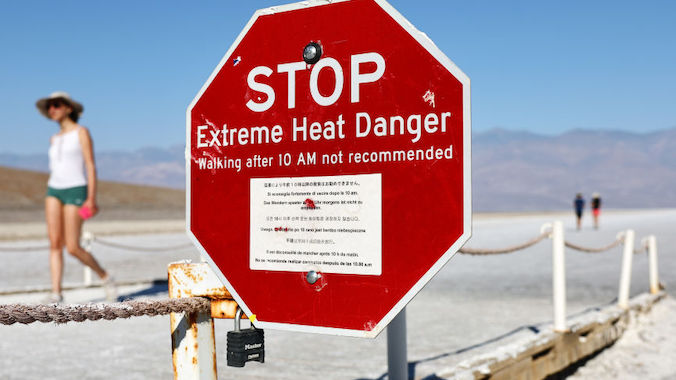Are You Enjoying Summer Yet?
Photo by Mario Tama/Getty Images
The heatings will continue until morale improves.
The heat wave that has absolutely torched the western part of the country over the last week is now meandering its way east. The remnants of Hurricane Beryl, which has left the Houston area dangerously wet, dark, and hot, are now wandering across the Northeast, yielding yet more flood watches and warnings. It has officially been summer for only three weeks.
- Bernie Sanders and Some Democrats Get Ready to Lick Elon’s Boots and Practice the Politics of the Past
- NBC Seems to Suggest a Children's Video Game is to Blame for UnitedHealthcare CEO's Killing
- Nancy Mace Is an Irredeemable Garbage Person Who Loves Bullying Vulnerable People and Yet the Media Still Believes Her
“Dangerous and record-breaking heat will continue for much of the West through Saturday, while sizzling temperatures will also begin to build across the Central Plains and Southeast,” warned the National Weather Service on Friday morning. “Hazardous heat will expand in coverage over portions of the central and eastern U.S. late this weekend.”
West, Central Plains, Southeast, central and eastern U.S…. how thorough.
Las Vegas suffered through almost a week straight of 115-degree days; Saturday will finally offer some relief, with a high of, uh, 113 degrees. At least 28 people have died from the heat in western states this month — a number sure to climb, as heat-related deaths often take some time to become clear.
More than a million Texas electricity customers still lacked power on Friday morning, and utilities have warned that half a million in the Houston area may not get it back until next week even as they struggle to clean up from Beryl’s flooding. Hospitals are “backed up” as they are reluctant to discharge patients to homes without air conditioning, and ambulances have waited hours just to drop off patients. Temperatures in the area will be in the 90s over the weekend; when the waters recede and the dust clears, this could end up as the biggest disaster the country has seen yet this year.
And that’s saying something: The National Oceanic and Atmospheric Administration reported recently that the country has already seen 15 billion-dollar weather disasters in 2024 — and that’s before Beryl or the ongoing heat wave have been accounted for. The 1980 to 2023 average is 8.5 billion-dollar disasters; over the last five years, that average is 20.4. This year will end comfortably above that mark.